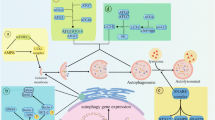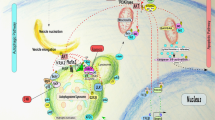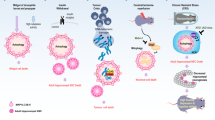Abstract
Autophagy, which is one of the most important ways to maintain cell homeostasis plays an important regulatory role in cell survival and death. Currently, it is agreed that autophagy promotes or inhibits cell death depending on the internal and external environment and cell type. On the one hand, under normal nutritional conditions autophagy regulates cell survival by energy sensing through the main energy sensing cascade kinases. On the other hand, autophagy regulates the process of cell death. mTOR, Beclin 1, caspases, FLIPs, DAPK, and Tp53 play important regulatory roles in autophagy and apoptosis highlighting the crosstalk between the mechanisms underlying the two death modes. However, energy deficiency caused by PARP1 over-activation and DAPK-PKD pathway activation induces necrosis and autophagy, highlighting the interaction between the two pathways. In addition, autophagy regulates cell death through epigenetic regulation such as histone modification. More investigations on the relationship between autophagy and cell death is ongoing. In the future, there will be more challenges in the study of the relationship between autophagy and cell survival and death. As research increasingly focuses on cell death, the relationship between autophagy and existing and newly discovered cell death types is likely to become more complex. The elucidation of the regulatory role of autophagy in cell survival and death requires more research. Some research results are likely to provide hot topics for further investigations on diseases related to cell death disorders and an experimental basis for the targeted regulation of autophagy for specific treatment of diseases.
Access this chapter
Tax calculation will be finalised at checkout
Purchases are for personal use only
Similar content being viewed by others
Abbreviations
- ACD:
-
Accidental cell death
- AIF:
-
Apoptosis-inducing factor
- AMPK:
-
Adenosine 5′-monophosphate (AMP)-activated protein kinase
- Bruce:
-
BIR-containing ubiquitin-conjugating enzyme
- CMA:
-
Chaperone-mediated autophagy
- CSE:
-
Cigarette smoke extract
- DISC:
-
Fas-dependent death-inducing signaling complex
- DRAM:
-
Damage-regulated autophagy modulator
- FADD:
-
FAS-associated death domain
- FAK:
-
Focal adhesion kinase
- FLICE:
-
FADD-like interleukin-1 beta-converting enzyme
- FLIP:
-
Flice inhibitory protein
- GABARAP-L1:
-
Γ-aminobutyric acid receptor-associated protein-like 1
- HAT:
-
Histone acetyltransferase
- HDAC:
-
Histone deacetylase
- HMGB1:
-
High mobility group B1
- IAPs:
-
Inhibitor of apoptosis proteins
- IFN:
-
Interferon
- IL3:
-
Interleukin 3
- IMS:
-
Intermembrane space
- LAMP2A:
-
Lysosome-associated membrane protein type 2A
- MEF2D:
-
Myocyte enhancer factor 2D
- MEFs:
-
Mouse embryonic fibroblasts
- MFN1:
-
Mitofusin 1
- MOMP:
-
Mitochondrial outer membrane permeabilization
- mTOR:
-
Mammalian target of rapamycin
- NBR1:
-
The neighbor of BRCA1 gene 1
- NCCD:
-
Nomenclature Committee on Cell Death
- PARKIN:
-
Parkinson’s disease protein
- PINK1:
-
PTEN-induced putative kinase 1
- PKA:
-
Protein kinase A
- PKD:
-
Protein kinase D1
- PTP:
-
Permeability transition pore
- RCD:
-
Regulated cell death
- RIP1:
-
Kinases receptor-interacting protein 1
- ROS:
-
Reactive oxygen species
- SMAC:
-
Second mitochondria-derived activator of caspase
- SQSTM1:
-
Sequestosome 1, p62
- TNF:
-
Tumour necrosis factor
- TNF/NGF:
-
Tumor necrosis factor/nerve growth factor
- TRAIL:
-
TNF-related apoptosis-inducing ligand
- VDAC1:
-
Voltage-dependent anion-selective channel 1
- VMP1:
-
Vacuole membrane protein
References
Chang CR, Blackstone C (2007) Cyclic AMP-dependent protein kinase phosphorylation of Drp1 regulates its GTPase activity and mitochondrial morphology. J Biol Chem 282(30):21583–21587
Chen Z, Nie SD, Qu ML et al (2018) The autophagic degradation of Cav-1 contributes to PA-induced apoptosis and inflammation of astrocytes. Cell Death Dis 9(7):771
Egan DF, Shackelford DB, Mihaylova MM et al (2011) Phosphorylation of ULK1 (hATG1) by AMP-activated protein kinase connects energy sensing to mitophagy. Science 331(6016):456–461
Eisenberg-Lerner A, Kimchi A (2012) PKD is a kinase of Vps34 that mediates ROS-induced autophagy downstream of DAPk. Cell Death Differ 19(5):788–797
Fernandez AF, Sebti S, Wei YJ et al (2018) Disruption of the beclin 1-BCL2 autophagy regulatory complex promotes longevity in mice. Nature 558(7708):136–140
Fullgrabe J, Heldring N, Hermanson O et al (2014) Cracking the survival code autophagy-related histone modifications. Autophagy 10(4):556–561
Galluzzi L, Vitale I, Aaronson SA et al (2018) Molecular mechanisms of cell death: recommendations of the Nomenclature Committee on Cell Death 2018. Cell Death Differ 25(3):486–541
Garcia-Prat L, Martinez-Vicente M, Perdiguero E et al (2016) Autophagy maintains stemness by preventing senescence. Nature 529(7584):37–42
Goodall ML, Fitzwalter BE, Zahedi S et al (2016) The autophagy machinery controls cell death switching between apoptosis and necroptosis. Dev Cell 37(4):337–349
Gozuacik D, Bialik S, Raveh T et al (2008) DAP-kinase is a mediator of endoplasmic reticulum stress-induced caspase activation and autophagic cell death. Cell Death Differ 15(12):1875–1886
Ichimura Y, Waguri S, Sou Y et al (2013) Phosphorylation of p62 activates the Keap1-Nrf2 pathway during selective autophagy. Mol Cell 51(5):618–631
Imagawa Y, Saitoh T, Tsujimoto Y (2016) Vital staining for cell death identifies Atg9a-dependent necrosis in developmental bone formation in mouse. Nat Commun 7:13391
Jangamreddy JR, Los MJ (2012) Mitoptosis, a novel mitochondrial death mechanism leading predominantly to activation of autophagy. Hepat Mon 12(8):e6159
Lee JS, Li QL, Lee JY et al (2009) FLIP-mediated autophagy regulation in cell death control. Nat Cell Biol 11(11):1355–1362
Luo S, Rubinsztein DC (2010) Apoptosis blocks Beclin 1-dependent autophagosome synthesis: an effect rescued by Bcl-xL. Cell Death Differ 17(2):268–277
Mihaylova MM, Shaw RJ (2011) The AMPK signalling pathway coordinates cell growth, autophagy and metabolism. Nat Cell Biol 13(9):1016–1023
Pan HH, Yan Y, Liu CY et al (2017) The role of ZKSCAN3 in the transcriptional regulation of autophagy. Autophagy 13(7):1235–1238
Pattingre S, Tassa A, Qu XP et al (2005) Bcl-2 antiapoptotic proteins inhibit Beclin 1-dependent autophagy. Cell 122(6):927–939
Poillet-Perez L, Xie XQ, Zhan L et al (2018) Autophagy maintains tumour growth through circulating arginine. Nature 563(7732):569–573
Sun L, Meng ZY, Zhu YF et al (2018) TM9SF4 is a novel factor promoting autophagic flux under amino acid starvation. Cell Death Differ 25(2):368–379
Tan MJ, Luo H, Lee S et al (2011) Identification of 67 histone marks and histone lysine crotonylation as a new type of histone modification. Cell 146(6):1015–1027
Yamaguchi T, Suzuki T, Sato T et al (2018) The CCR4-NOT deadenylase complex controls Atg7-dependent cell death and heart function. Sci Signal 11(516):eaan3638
Yu L, McPhee CK, Zheng LX et al (2010) Termination of autophagy and reformation of lysosomes regulated by mTOR. Nature 465(7300):942–946
Zaffagnini G, Savova A, Danieli A et al (2018) p62 filaments capture and present ubiquitinated cargos for autophagy. EMBO J 37(5):e98308
Zhang GM, Wang Z, Du Z et al (2018) mTOR regulates phase separation of PGL granules to modulate their autophagic degradation. Cell 174(6):1492–1506
Author information
Authors and Affiliations
Corresponding author
Editor information
Editors and Affiliations
Rights and permissions
Copyright information
© 2019 Science Press and Springer Nature Singapore Pte Ltd.
About this chapter
Cite this chapter
Yan, X., Zhou, R., Ma, Z. (2019). Autophagy—Cell Survival and Death. In: Qin, ZH. (eds) Autophagy: Biology and Diseases. Advances in Experimental Medicine and Biology, vol 1206. Springer, Singapore. https://doi.org/10.1007/978-981-15-0602-4_29
Download citation
DOI: https://doi.org/10.1007/978-981-15-0602-4_29
Published:
Publisher Name: Springer, Singapore
Print ISBN: 978-981-15-0601-7
Online ISBN: 978-981-15-0602-4
eBook Packages: Biomedical and Life SciencesBiomedical and Life Sciences (R0)




